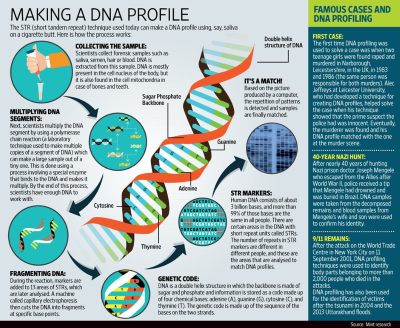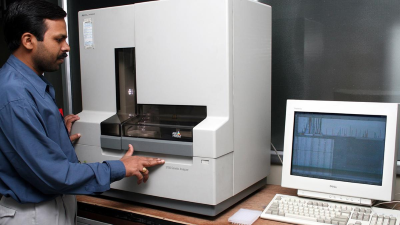Context: The role of DNA evidence in criminal cases is often depicted as decisive, with popular media suggesting it can make or break a case. However, the reality of DNA profiling is more nuanced. Recent judicial rulings, such as those by the Madras High Court, highlight the complexities and limitations of relying solely on DNA evidence to determine guilt or innocence.
Deoxyribonucleic Acid (DNA)
Recent Judicial Developments
In mid-June 2024, the Madras High Court overturned the conviction of a man accused of rape under the POCSO Act. The court found merit in the appellant's argument that, despite a DNA test establishing his paternity, the case against him was not proven beyond reasonable doubt. The victim had initially claimed the appellant committed the assault but later admitted she had falsely accused him to avoid exposing a personal affair. The conviction was based primarily on a DNA report that indicated a 99.999999998% probability of the appellant being the father of the victim's child.
Understanding DNA
DNA, or deoxyribonucleic acid, is the genetic material present in the nuclei of cells. Each human body contains approximately 100 trillion cells, each with DNA organised into 23 pairs of chromosomes. DNA encodes all genetic information in a sequence of four nucleotides: Adenine (A), Guanine (G), Thymine (T), and Cytosine (C). This genetic material can be sourced from various biological materials such as blood, saliva, semen, and hair. However, some sources like touch DNA contain very low amounts of DNA, making them less ideal for profiling.
The Role of DNA in the Criminal Justice System
Reliability of DNA Profiling
DNA profiling involves analysing specific locations in the DNA, known as loci, which contain repetitive sequences called Short Tandem Repeats (STRs). Each individual has unique variations in these STRs, known as alleles. Forensic DNA profiling focuses on these STRs to create a DNA profile. The process includes isolation, purification, quantitation, amplification of markers, visualisation, and statistical analysis. Despite advances in technology, DNA profiling remains based on probabilities and is not infallible.
The DNA in Forensic Science
DNA, or deoxyribonucleic acid, is a unique genetic identifier inherited from one's ancestors. Each individual's DNA pattern is distinct, except for identical twins. An adult’s DNA encompasses over three billion characteristics, though only 13 are necessary for effective profiling. The discovery of DNA is considered one of the most pivotal biological breakthroughs of the 20th century, revolutionising forensic science and providing critical support in criminal investigations and civil disputes.
Advancements in Criminal Identification and Justice
Previously, crime scene identification relied on physical evidence like fingerprints, footprints, or blood samples. Unlike these, DNA can be preserved indefinitely and remains usable even from decomposed remains. This durability has proven crucial in identifying victims and exonerating the innocent. The ability to match a suspect’s DNA to crime scene evidence has enhanced the tools available to law enforcement and courts, significantly advancing the accuracy and effectiveness of criminal justice delivery.

Challenges and Limitations
Reliability and Handling of DNA Evidence
The reliability of DNA evidence can be compromised by issues such as sample contamination, delays in testing, or mislabeling of samples. Dr. Manikanda Raj of Chengalpattu Medical College and Hospital emphasises that DNA evidence should not be the sole basis for convictions without corroborating evidence. In Tamil Nadu, the entire process of DNA sample handling is videographed to prevent contamination and ensure accuracy.
Ethical Concerns with DNA Profiling
DNA profiling, while valuable, raises significant ethical concerns regarding privacy and misuse. Beyond revealing physical traits, DNA can disclose sensitive health information, leading to privacy issues, especially with indefinite storage in databases. The Supreme Court's recognition of privacy as a fundamental right has intensified scrutiny of DNA data management, with ongoing debates about its use in systems like Aadhaar.
Additional concerns include the potential for abuse, such as DNA planting, misinterpretation, and errors leading to wrongful convictions. The Phantom of Heilbronn case highlighted flaws in forensic procedures. Misuse of DNA data for purposes like data mining, as seen in the Cambridge Analytica scandal, and practices such as DNA dragnets can disproportionately target minority communities, raising concerns about civil liberties.
|
Laws in Other Countries Over the past 25 years, many nations have enacted DNA fingerprinting laws and established databases for criminal investigations, disaster identification, and forensic science. ● USA: In the early 1990s, the FBI created the Combined DNA Index System (CODIS), a national database with over 12 million offender profiles, 2.5 million arrestee profiles, and 750,000 forensic profiles. CODIS has supported over 350,000 investigations and produced more than 365,000 matches. ● United Kingdom (UK): The National DNA Database (NDNAD) in the UK holds DNA profiles for approximately 7% of the population. ● China: China enacted a law in 1999 enabling the Ministry of Justice and the Ministry of Interior to create DNA Banks. ● Canada: The DNA Identification Act of 2000 established a DNA databank and updated the criminal code. ● Europe: Countries such as Holland, Germany, France, and Austria restrict DNA profiling to individuals convicted of serious crimes. |
Probative Value of DNA Evidence
Random Occurrence Ratio
According to the Madras High Court, there are three possible outcomes when comparing DNA profiles: match, exclusion, or inconclusive. A match indicates identical profiles, an exclusion shows differences, and inconclusive results fail to support a definitive conclusion. The Law Commission of India’s 2003 report noted that even if profiles match, it does not conclusively prove identity. The "random occurrence ratio" from a database indicates how often similar profiles appear, which is useful for investigation but not definitive for court determinations.
Case Law on DNA Evidence
In the 2019 case of Pattu Rajan v. State of T.N., the court highlighted that the probative value of DNA evidence varies depending on the case's facts and other evidence presented. While DNA accuracy is improving, it is not yet infallible, and the absence of DNA evidence should not automatically lead to an adverse inference against a party if other reliable evidence supports their case.
Conclusion
As DNA profiling technology continues to advance, its value in criminal proceedings remains significant but not absolute. Judicial caution is necessary to ensure that DNA evidence is used in conjunction with other corroborative evidence to establish guilt or innocence accurately.
|
Probable Questions for UPSC Mains 1. Discuss the role of DNA profiling in the criminal justice system, highlighting its advantages and limitations. How have recent judicial rulings in India, such as the Madras High Court's decision in June 2024, shaped the understanding of DNA evidence in determining guilt or innocence? (10 Marks, 150 Words) 2. Examine the ethical concerns associated with DNA profiling, particularly in the context of privacy and potential misuse. How do different countries handle DNA databases and forensic evidence, and what implications do these practices have for civil liberties and the accuracy of criminal investigations? (15 Marks, 250 Words) |
Source: The Hindu









